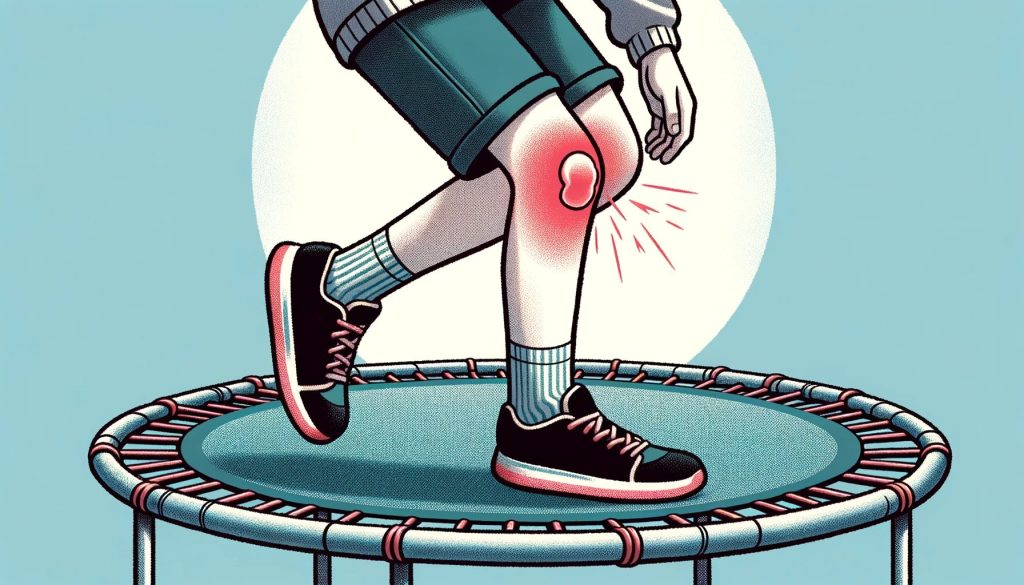No, most of the time, jumping on a trampoline is not bad for your knees. It is a common misconception that jumping on a trampoline is bad for your knees. In fact, jumping on a trampoline can actually be good for your knees!
Trampolining is a great form of exercise that helps to improve knee strength, joint stability, and overall physical fitness. It is also an effective way to lose body weight and improve cardiovascular health.
In this blog post, we’ll see everything about jumping on a trampoline and its effects on your knees.
How does jumping on a Trampoline Affect your knees?
The answer may surprise you. Jumping on a trampoline is actually great for your knees! The impact of jumping on a trampoline helps to strengthen the core muscles and ligaments around your knees and can even help to reduce knee pain.

Let’s not forget the facts. Generally, jumping on a trampoline puts three times more stress on your knees than running. This type of impact can cause long-term damage and lead to arthritis down the line.
So if you have any pre-existing knee problems, it’s best to consult with a doctor before starting to jump on a trampoline.
However, For most people, it will be beneficial for knees rather than harmful.
Things That May Impact Knee Injuries When Trampolining
1. Trampoline Quality

Importance of Springs: The quality of a trampoline, especially its springs, plays a pivotal role in impact absorption. High-quality trampolines with well-designed springs can significantly reduce the force exerted on the knees, minimizing the risk of injury. On the other hand, trampolines of inferior quality may not provide adequate cushioning, leading to increased stress on the knees.
Mat Condition: A good quality mat in prime condition ensures that the impact on the knees is evenly distributed. A worn-out or damaged mat can lead to uneven force distribution, increasing the chances of knee injuries.
2. Overweight

Increased Stress on Knees: Being overweight can exert additional stress on the knees, even during regular activities. When trampolining, this added weight can amplify the force on the knees, making them more susceptible to trampoline injuries.
Cardiovascular Benefits: On the positive side, trampolining can be an effective way to lose body weight and improve cardiovascular health, provided it’s done with caution and awareness of one’s physical limits.
3. Risky Flips

Advanced Maneuvers: While flips and other advanced maneuvers can be thrilling, they come with increased risks. Landing incorrectly from a flip can put an immense strain on the knees, leading to sprains or even more severe trampoline related injuries.
Experience Matters: Such risky moves should only be attempted by experienced trampolinists who have received proper training. Beginners should always start with basic jumps and gradually progress as they gain more confidence and skill.
4. Overjumping
Repetitive Motion Strain: Continuously jumping with great force or for extended periods can lead to repetitive motion strain. This repetitive stress can harm the knees over time, leading to wear and tear of the ligaments and joints.
Importance of Breaks: It’s essential to take frequent breaks during trampolining sessions to rest the knees and prevent fatigue. Listening to one’s body and recognizing signs of strain can go a long way in preventing potential injuries.
While trampolining can be a fun and beneficial activity, it’s essential to be aware of the factors that can impact knee health.
Precautions to protect your knees when jumping on a trampoline
Jumping on a trampoline can be a fun way to get exercise, but it’s important to take precautions to protect your knees from injury. Here are some tips:
- Warm up properly: Before you start trampoline exercise like jumping, warm up your muscles with some gentle stretching and light cardio exercises.
- Good Quality Mat: Make sure you have a good quality mat that is in good condition.
- Jump in the center: Try to jump in the center of the trampoline and avoid landing on the edge.
- Wear appropriate shoes: Make sure you wear shoes with good support and grip to avoid slipping or twisting your ankle.
- Start slowly: Begin by jumping lightly and gradually increase your intensity as you warm up.
- Keep your knees slightly bent: When jumping, make sure to keep your knees slightly bent to absorb the impact of each jump.
- Use proper technique: Try to land on the center of the trampoline and avoid jumping too high or too close to the edge, as this can increase your risk of injury.
- Supervision: Always jump under the supervision of a responsible adult, especially if you are a beginner.
- Avoid risky moves: Don’t attempt any risky moves, such as flips or twists, unless you are an experienced trampolinist.
- Take breaks: Take frequent breaks to rest your knees and prevent fatigue.
By following these precautions, you can reduce your risk of knee injury while jumping on a trampoline.
Can you still jump on a trampoline if you have bad knees?
The answer is yes and no. You can still jump on a trampoline if you have bad knees. However, you will want to take some precautions to avoid further injuring your knees. Make sure you warm up before jumping and stretch your legs well.
You can start with small trampoline jumps and work your way up to bigger ones. If you start to feel severe pain, stop jumping and rest for a bit. To start small, you can jump on a mini trampoline, and later you can move to a big outdoor trampoline.
Jumping itself can be hard on the knees. If you already have knee issues, this could exacerbate them. If that isn’t enough to deter you from jumping, consider the strain you are putting on your knees when you push up to jump.
The strain can get worse when you jump higher to achieve the desired altitude. This can aggravate an existing knee injury or cause a new one. So, make sure you fully understand the consequences.
How can you prevent trampoline knee injuries from happening in the first place?

The best way to prevent trampoline knee injuries is by using proper safety equipment. Wearing a properly fitting knee joint brace can help stabilize the knee and prevent it from hyperextending.
Additionally, using a trampoline mat can help cushion the impact of landing on the trampoline and reduce the risk of injury. Always be sure to jump in the center of the trampoline to avoid landing on the frame or springs. Also, avoid landing on your knees, as this can put unnecessary stress on the joint. If you do experience a knee injury while using a trampoline, be sure to see a doctor right away. Early diagnosis and treatments are essential for preventing long-term damage.
With proper trampoline safety precautions, you can help reduce the risk of repetitive stress injuries.
Does jumping have any adverse effect on knee pain?
The answer is yes or no. It all depends on how you perform the jump.
If you land properly, with your knees bent and not locked, jumping can actually help reduce knee pain.
However, if you land with your knees locked or straightened, it can actually aggravate knee pain.
So there you have it; regular trampoline jumping can help reduce knee pain as long as you do it correctly! And always remember to bend your knees when landing to avoid any potential injury.
How can I fix my Jumping Knee problem permanently?

If you’re experiencing knee pain while jumping, it’s important to consult with a doctor or physical therapist to find the root cause of the problem. Once you know what is causing the pain, you can begin working on exercises and stretches to correct the issue.
With proper treatment, most people are able to fix their jumping knee problem permanently. So if you’re experiencing knee joint pain, don’t hesitate to seek help!
What are some other exercises that are good for your knees?
Knee bends

While standing, slowly bend your knees, then raise yourself back up. Do two sets of 15.
Leg lifts
Lie on your back with a pillow/your hand under your head and one under each knee. Slowly raise one leg about six inches and hold for three seconds. Return to the starting position and repeat with the other leg. Do two sets of 15.
Leg lifts and stair climbing
If you have access to stairs, stand on a step and slowly lower your heels below the level of the step. Hold for two seconds and raise yourself back up. Do two sets of 15.
Lunges

Step forward with one leg and lower your body until your thigh is parallel to the ground. Keep your back straight and don’t let your knee extend past your toe. Return to the starting position and repeat with the other leg. Do two sets of 15.
Knee extensions
Sit in a chair with your knees bent at a 90-degree angle and your feet flat on the floor. Slowly straighten your knees until your legs are straight. Hold for two seconds and return to the starting position. Do two sets of 15.
Quadriceps sets
Lie on your stomach with a pillow under your hips. Bend one knee and grab your ankle with your hand. Straighten your leg until it is in line with your hip. Hold for five seconds and return to the starting position. Repeat with the other leg. Do two sets of 15.
Hamstring curls
Lie on your back with a pillow under your hips. Bend one knee and grab your ankle with your hand. Straighten your leg until it is in line with your hip. Hold for five seconds and return to the starting position. Repeat with the other leg. Do two sets of 15.
Isometric knee exercises
Sit in a chair with your knees bent at a 90-degree angle and your feet flat on the floor. Place a towel around your thigh just above your knee. Press against the towel with both hands for five seconds. Relax and repeat. Do two sets of 15.
These exercises can help to improve the range of motion in your knees and strengthen the knee muscles that support them. Be sure to talk to your doctor before starting any new exercise routine.
FAQ – Is jumping on Trampoline bad for Knees?
Does jumping strengthen knees?
Yes, Jumping can strengthen the muscles around the knees, enhancing joint stability and support. However, over time or with excessive force, repetitive jumping can strain the knees. It’s essential to progress gradually.
What precautions should I take when rebounding with bad knees?
Use a quality rebounder with a good bounce, wear supportive shoes, and consider using stability bars. Listen to your body and stop if you feel pain.
Does trampolining damage your knees?
Not at all. But yeah, improper technique or overuse may exert strain on knees.
Conclusion
So, is jumping on a trampoline bad for your knees? I hope after reading the article, you know that jumping on a trampoline is not bad at all for your knees. In fact, it is relatively safe for your knees as long as you are doing it correctly.
In fact, it might actually be good! Trampolining provides an excellent workout for your legs and helps to improve knee function. In short, it has a lot of health benefits. So go ahead and have some fun bouncing around – your knees will thank you for it.
Sources:
- Does trampoline or hard surface jumping influence lower extremity alignment? A study by Kiyokazu Akasaka et al.
- Trampoline Versus Resistance Training in Young Adults. A study by Zhong et al.
- 8 Best Mini Trampoline For Seniors | Detailed Review - May 11, 2023
- What is the Best Outdoor Trampoline For Adults? - May 10, 2023
- How To Keep Trampoline From Blowing Away (Best Way To Anchor A Trampoline) - May 9, 2023

